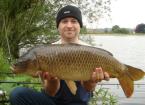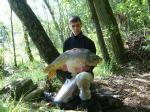Many fishermen get an anxiety attack thinking about their baits in winter and rightly so! Most commercially produced baits are not made to be ideal winter baits but in part to fulfil typical customer expectations which lead to more buyer confidence in the bait. This produces quite a few baits having constant features which may not necessarily always lead to the best bait option.
For example, such a winter bait will last more than 12 hours in water as a functional durable hook bait. Or exude a smell which is recognisable to a buyer to fit a current fashion (like pineapple for example. Or have a fair degree of initial hardness when first immersed in water and even have a dry centre. Such baits require a period of soaking in order to allow the bait to open up its texture and structure enough to release good soluble attraction into the water. Often winter baits can be so over-flavoured that they repel fish. Over-flavouring of baits works but can be a disadvantage on many waters where the same bait and flavours have been used too much to keep a real edge.
Many effective winter baits having a more open texture, containing more coarse ingredients like bird foods, (egg biscuit, hempseed, wheat germ meal etc,) the levels are often in less than ideal proportions that could lead to a more attractive and digestible bait. A bait with an open soft structure and capable of leaching soluble attractors while retaining attractive nutritional signals and taste factors is often much better than a dense textured bait which inhibits the dispersal of its attractors even if its a high protein milk protein bait. Very important taste signals which are received by carps taste receptors can directly influence the longevity of feeding on your bait and even if it is eaten at all.
Many baits will have high proportions of finely milled flours. In some carp studies it was found that carp preferred to eat coarse food items such as cracked maize, as opposed to finely milled maize flour made into dough balls. (This has much to do with nutrition being lost during the milling process – taste the difference between milled oats and natural oats for example.) Cracking open a piece of natural maize releases more concentrated flavour than the dough balls made from maize flour.
There has been a long growing trend towards use of so-called ‘food baits’ by carp anglers in many countries. This in theory means that carp get used to eating such a bait feeling the nutritional benefits that it contains and keep coming back for more. Such baits retain higher levels of taste substances after long immersion in water, than say a cheap ‘crap bait’ made from soya, semolina, rice flour or maize meal.
The cheap low food value bait base mix has very little in regards to nutritional attraction which contribute to taste attraction. In the case of the average commercially produced bait, results are often very similar between them because the ingredients used are so often the same or very similar and are offering similar nutritional rewards. Having been fed on these baits constantly by numbers of anglers and being hooked on them often fish can reduce their feeding on this bait now they need this supplemental nutrition offered less.
Some anglers say that carp do not differentiate between different anglers’ balanced nutritional baits, arguing they will eat them all anyway once flavours and most taste factors have leached out; the real difference being an individual angler’s abilities. This is very true in that years ago a low nutrition bait with a flavour could not match the attraction profile and nutritional rewards of constantly eating a balanced nutritional bait. At that time such baits could really produce astounding results. But these days most busy carp waters are fed such a wide range of baits, (which now form much of the bulk of the fish stocks diet,) that differences in catch rates between the commercially produced baits are mostly very similar, with few really standing out for long.
Even the new baits with added enzymes claiming to contain ‘optimum levels of the right amino acids for the best concentration and release of the most stimulating amino acids to carp,’ do not seem to work everywhere to the same degree of success compared to average baits. It seems that every carp water is different in regards to the relative nutritional requirements and possible deficiencies or not that carp may have. Much depends upon exactly how carp respond to each type of bait as a direct consequence of the nutrition that can be detected in it and efficiently digested and assimilated from it. There is evidence that use of the new generation of more highly preserved quality food baits, when used together with low flavour fresh frozen type baits on the same base mix can offer special attraction advantageous.
It’s the bait which offers more stimulating taste or a different nutritional attraction profile or a more stimulatory physiological effect that can get around the natural and angler-conditioned defences of carp. Many anglers have missed the potent physiological effects of essential oil mixtures including improved digestion and changes metabolism stimulation. An energized cold water carp is going to move faster and further, be more generally active, eat more bait, give you more chances of more pick-ups and even more far enough fast enough to self-hook itself against your lead, when they might otherwise not do so. I am personally extremely interested in the physiological, physical, mental, mood altering, general health and energy promoting effects of carp bait additives and ingredients. We have been catching carp for years by ‘drugging them’ and fishing baits are now more scientifically complex now than ever before.
The author has many more fishing and bait ‘edges.’ Just one could impact on your catches.
By Tim Richardson.
For the unique and acclaimed new massive expert bait making / enhancing ‘bibles’ ebooks / books:
“BIG CATFISH AND CARP BAIT SECRETS!”
And: “BIG CARP BAIT SECRETS!” (AND “FLAVOUR, FEEDING TRIGGERS AND CHEMORECEPTION SECRETS”) SEE:
http://www.baitbigfish.com
Tim Richardson is a homemade carp and catfish bait-maker, and proven big fish angler. His bait making and bait enhancing books / ebooks are even used by members of the “British Carp Study Group” for reference. View this dedicated bait secrets website now..

